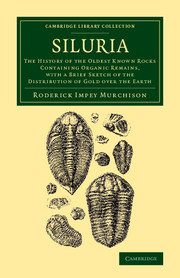
-
Select format
-
- Publisher:
- Cambridge University Press
- Publication date:
- 05 February 2015
- 02 January 2014
- ISBN:
- 9781107360488
- 9781108067195
- Dimensions:
- Weight & Pages:
- Dimensions:
- (216 x 140 mm)
- Weight & Pages:
- 0.78kg, 624 Pages
You may already have access via personal or institutional login
Book description
The Scottish geologist Sir Roderick Impey Murchison (1792–1871) first proposed the Silurian period after studying ancient rocks in Wales in the 1830s. Naming the sequence after the Silures, a Celtic tribe, he believed that the fossils representing the origins of life could be attributed to this period. This assertion sparked a heated dispute with his contemporary Adam Sedgwick, ultimately ruining their friendship. First published in 1854, Siluria is a significant reworking of Murchison's earlier book, The Silurian System, which had appeared in 1839. Thorough in his approach, he combines his own findings with those of researchers around the world, touching also on the later Devonian, Carboniferous and Permian periods as well as questions of natural history. An important text in nineteenth-century geology and palaeontology, the work contains a valuable geological map of Wales along with detailed engravings of fossils, including crustaceans, cephalopods and fish.
Contents
Metrics
Full text views
Full text views help Loading metrics...
Loading metrics...
* Views captured on Cambridge Core between #date#. This data will be updated every 24 hours.
Usage data cannot currently be displayed.
Accessibility standard: Unknown
Why this information is here
This section outlines the accessibility features of this content - including support for screen readers, full keyboard navigation and high-contrast display options. This may not be relevant for you.
Accessibility Information
Accessibility compliance for the PDF of this book is currently unknown and may be updated in the future.

